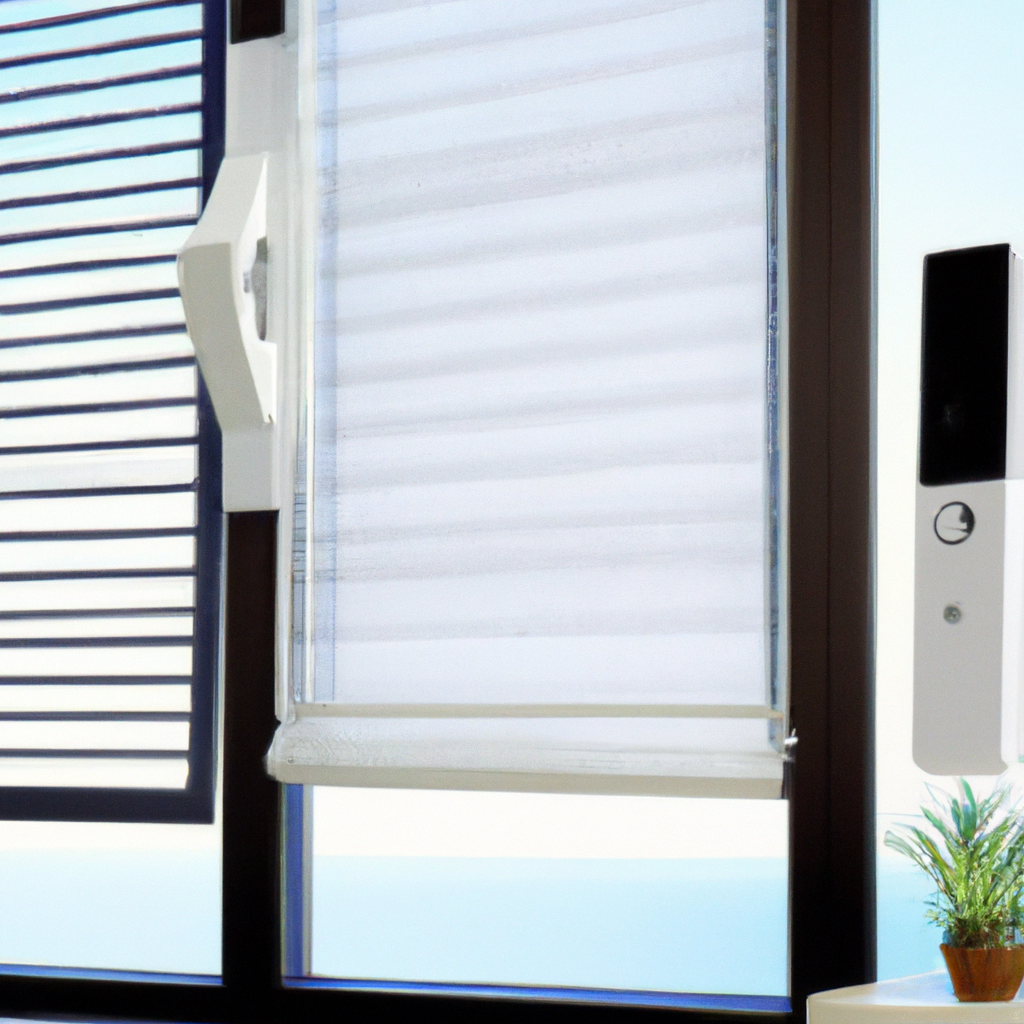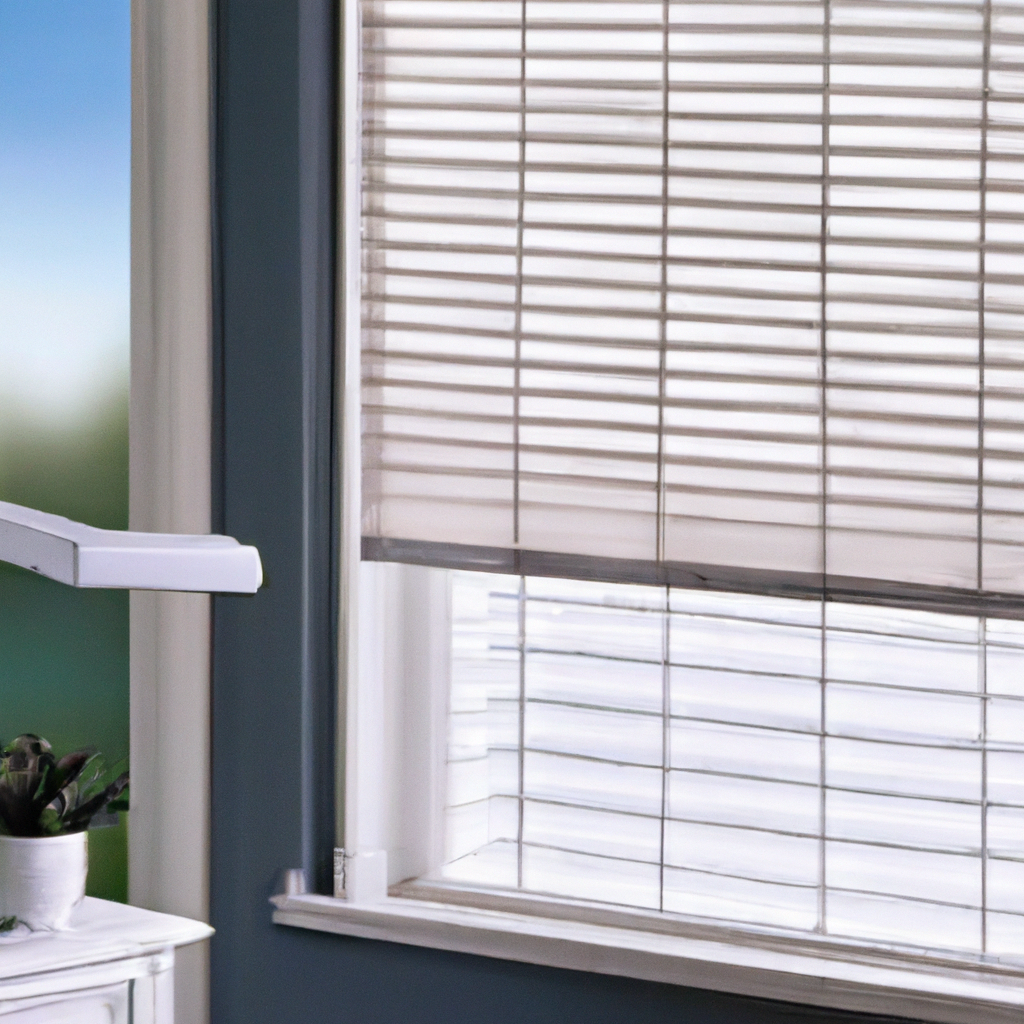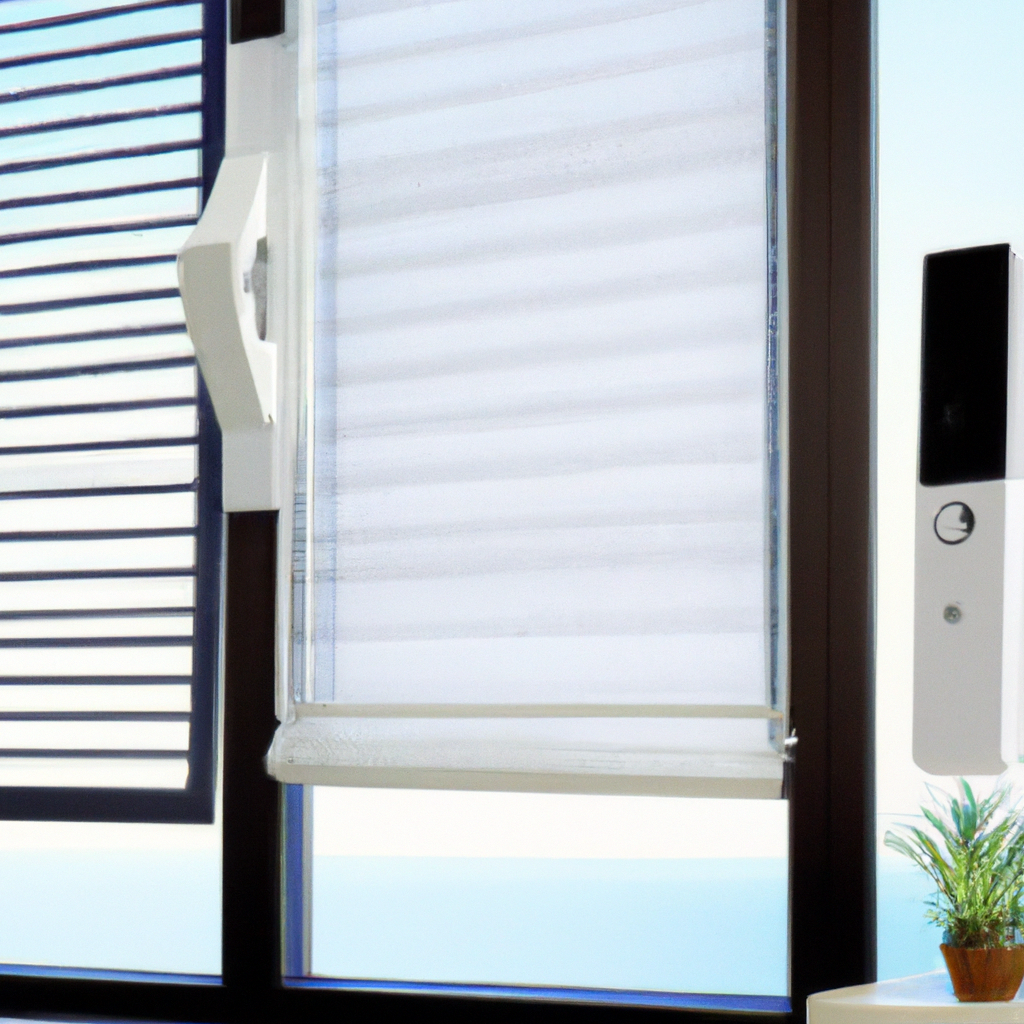Imagine sitting in your living room, basking in the warm glow of natural sunlight streaming through your windows. Now, imagine being able to effortlessly adjust your window shades with the touch of a button, without even having to get up from your cozy spot on the couch. In today’s world of smart home technology, controlling your window shades has never been easier or more convenient. From voice commands to smartphone apps, there are a variety of options available that bring a new level of control and simplicity to your living space. So, let’s take a closer look at the options for controlling smart window shades in a living room, and how they can enhance both the aesthetic and functionality of your home.

1. Remote Controls
1.1 Infrared Remote
An infrared remote is a common and affordable option for controlling smart window shades in a living room. This type of remote uses infrared technology to transmit signals to the shades, allowing you to open, close, or adjust the position of the shades without having to physically touch them. Infrared remotes are simple to use and typically have buttons or a touchscreen interface to control the shades.
1.2 Radio Frequency (RF) Remote
A radio frequency remote is another option for controlling smart window shades. Unlike infrared remotes, RF remotes use radio waves to communicate with the shades, which means you don’t need a direct line of sight to the shades for them to work. RF remotes can be more versatile in large or open spaces where infrared signals may be obstructed. With an RF remote, you can easily control multiple shades simultaneously, making it a convenient option for managing the shades in your living room.
1.3 Wi-Fi Remote
A Wi-Fi remote is a more advanced option for controlling smart window shades. These remotes connect to your home’s Wi-Fi network, allowing you to control the shades from your smartphone or tablet using a dedicated app. With a Wi-Fi remote, you can enjoy the convenience of controlling your shades from anywhere in the house, or even when you’re away from home. This option provides a high level of flexibility and customization, as you can create schedules, set timers, and even integrate the shades with other smart home devices.
2. Mobile Apps
2.1 Manufacturer-Specific Apps
Many smart window shade manufacturers offer their own dedicated mobile apps for controlling their products. These apps are designed to provide a seamless and intuitive user experience, allowing you to control your shades with ease. Manufacturer-specific apps often offer a wide range of features, including individual shade control, group control, scheduling options, and integration with other smart home devices. If you have smart window shades from a specific brand, using their dedicated app can be a great choice for controlling your shades in the living room.
2.2 Universal Smart Home Control Apps
If you have multiple smart devices in your home, you may prefer to use a universal smart home control app to manage all your devices, including your smart window shades. These apps, such as SmartThings, Google Home, or Apple HomeKit, offer compatibility with a variety of smart home devices from different manufacturers. By using a universal app, you can have all your smart devices in one place, making it convenient to control and automate your living room shades along with other devices. These apps usually provide advanced customization options and integration with voice control assistants.
2.3 Voice Control Integration
Voice control integration is an increasingly popular way to control smart window shades in a living room. By using voice commands, you can effortlessly open, close, or adjust the position of your shades without even lifting a finger. Voice control integration is usually available through voice assistants like Amazon Alexa, Google Assistant, or Apple Siri. You can pair your smart window shades with the voice assistant of your choice and then control them by simply speaking your commands. This hands-free option provides a convenient and futuristic way to manage your living room shades.

3. Wall Switches
3.1 Traditional Wall Switches
Traditional wall switches are a familiar and straightforward option for controlling smart window shades in a living room. These switches are installed directly on the wall and function similarly to standard light switches. They provide a physical interface to manually control the shades, allowing you to raise or lower them with a simple press of a button. Traditional wall switches are a reliable and cost-effective solution, particularly if you prefer a more tactile and traditional control method for your living room shades.
3.2 Smart Wall Switches
Smart wall switches offer a more advanced and integrated control option for smart window shades. These switches are connected to your home’s Wi-Fi network and can be controlled using a mobile app or voice commands. Smart wall switches often provide additional features like individual or group shade control, scheduling options, and integration with other smart home devices. With a smart wall switch installed in your living room, you can easily and conveniently manage your window shades without the need for separate remotes or mobile apps.
4. Voice Control
4.1 Amazon Alexa
Amazon Alexa is a popular voice assistant that can be used to control a wide range of smart home devices, including smart window shades. By pairing your shades with an Alexa-compatible hub or bridge, you can command Alexa to open or close the shades, adjust their position, or even create customized routines that include shade control. With Alexa’s natural language processing capabilities, controlling your living room shades becomes as simple as stating your desired commands.
4.2 Google Assistant
Google Assistant is another voice control option for managing smart window shades in your living room. By connecting your shades to a Google Assistant-enabled hub or using a compatible app, you can control the shades using voice commands. Google Assistant offers similar functionality to Alexa, allowing you to open, close, or adjust the position of your shades with ease. Additionally, Google Assistant can integrate with other smart home devices, enabling you to create seamless automation and control scenarios.
4.3 Apple Siri
For Apple users, Siri provides voice control capabilities for managing smart window shades in the living room. By connecting your shades to a HomeKit-enabled hub or using a compatible app, you can control your shades using Siri commands. Siri offers a range of control options, from basic commands like opening and closing the shades to more complex automation scenarios. With Siri’s integration with other HomeKit-compatible devices, you can create immersive and personalized smart home experiences in your living room.

5. Motion Sensors
5.1 Passive Infrared (PIR) Sensors
Passive Infrared (PIR) sensors can be utilized to automate the control of smart window shades in a living room. These sensors detect changes in infrared radiation, typically emitted by the human body, to determine when someone enters or leaves a room. By integrating PIR sensors with your smart window shades, you can configure the shades to automatically adjust based on occupancy. For example, the shades can be programmed to open when someone enters the room and close when the room is empty, ensuring both comfort and energy efficiency.
5.2 Ultrasonic Sensors
Ultrasonic sensors offer another option for motion-based control of smart window shades. These sensors emit ultrasonic waves and detect the reflections or changes in these waves to identify the movement of objects within a room. Ultrasonic sensors can be used to trigger shade control based on proximity or movement, allowing the shades in your living room to adjust automatically as you move around the space. This can provide convenience, privacy, and energy savings, especially in larger living rooms or open-plan areas.
5.3 Smart Hub Integration
Integrating smart window shades with a smart hub can further enhance their motion sensor capabilities. A smart hub acts as a central control point for all your smart devices, including motion sensors and window shades. By connecting motion sensors to a smart hub, you can create custom automation rules that determine how the shades should behave based on movement or occupancy. For example, you can configure the shades to close when no motion is detected in the living room for a specified period, ensuring privacy and reducing glare.
6. Timers and Schedules
6.1 Smart Hub Integration
Using a smart hub, you can take advantage of timers and schedules to automate the control of your smart window shades in the living room. Timers allow you to set specific times for the shades to open or close, providing privacy or maximizing natural light. Schedules, on the other hand, enable you to create more complex routines based on specific events or days. For example, you can schedule the shades to close automatically during the hottest part of the day to reduce heat gain or open them in the morning to let in natural sunlight.
6.2 Timer Plug Adapters
If you don’t have a smart hub, another option for incorporating timers into your living room shade control is by using timer plug adapters. These plug adapters can be inserted between the wall outlet and the shades’ power source, allowing you to set specific times for the shades to open or close. Timer plug adapters provide a cost-effective solution for automating your shade control, although they may offer fewer advanced features compared to a smart hub.
6.3 Manufacturer-Specific Apps
Many smart window shade manufacturers offer their own mobile apps with built-in timer and scheduling functionalities. These apps allow you to create custom schedules for your shades, specifying the desired opening and closing times. Manufacturer-specific apps often provide a user-friendly interface for setting up timers and schedules, making it easy to customize the control of your living room shades according to your preferences.

7. Light Sensors
7.1 Ambient Light Sensors
Light sensors can be used to automatically adjust the position of smart window shades based on the amount of natural light in the living room. Ambient light sensors detect the intensity of light in a room and send signals to the shades to open, close, or adjust accordingly. By integrating ambient light sensors with your smart window shades, you can achieve optimal light levels and energy efficiency in your living room. The shades can automatically close during the brightest parts of the day or open when natural light is dim, reducing the need for artificial lighting.
7.2 Smart Hub Integration
Integrating light sensors with a smart hub offers additional control capabilities for your smart window shades. By connecting light sensors to a smart hub, you can create customized automation rules that take into account both motion and ambient light levels. For example, you can set the shades to close automatically when both no motion is detected and the ambient light level exceeds a certain threshold, providing privacy and reducing glare. This integration allows for a more comprehensive and intelligent control of your living room shades.
7.3 Third-Party Automation
Third-party automation platforms, such as IFTTT (If This Then That), can be used to integrate light sensors with your smart window shades. These platforms allow you to create custom automation rules or “applets” that link various devices and services together. By creating an applet that triggers shade control based on light sensor readings, you can achieve seamless integration and create dynamic shade control scenarios in your living room.
7.4 Manufacturer-Specific Apps
Certain smart window shade manufacturers also offer their own mobile apps with built-in light sensor integration. These apps allow you to easily configure how the shades should react to changes in ambient light levels. You can set specific thresholds and define the desired shade positions, ensuring that your living room shades adjust to the perfect level of natural light throughout the day.
8. Smart Home Integration
8.1 Smart Hubs
Smart hubs play a crucial role in integrating and controlling various smart devices in a living room, including smart window shades. These hubs act as a central point of control and can communicate with multiple devices using different communication protocols. By connecting your smart window shades to a compatible hub, you can enjoy seamless integration with other smart home devices, such as lights, thermostats, and security systems. This integration allows for centralized control, automation, and synchronization of your living room’s smart features.
8.2 Third-Party Integration
In addition to smart hubs, many smart window shades are designed to be compatible with third-party integration platforms. These platforms, such as SmartThings or Hubitat, enable you to connect and control various smart devices from different manufacturers within a single ecosystem. By integrating your smart window shades with a third-party platform, you can create advanced automation and control scenarios that encompass multiple devices in your living room. This integration enhances the overall functionality and convenience of your smart home setup.
8.3 IFTTT (If This Then That)
IFTTT is a popular automation platform that allows you to create customized applets to connect and control different devices and services. For smart window shades in your living room, IFTTT can be used to link them with other smart devices or trigger actions based on external events. For example, you can create an applet that opens the shades when your security system is disarmed or closes them when you leave home. The flexibility and possibilities offered by IFTTT ensure that your living room shades seamlessly integrate with your desired smart home ecosystem.

9. Group Control
9.1 Smart Hub Integration
Group control is a convenient feature that allows you to control multiple smart window shades in your living room simultaneously. By integrating your shades with a smart hub, you can create groups or zones that encompass multiple shades. This enables you to control all the shades in a group with a single command or through automation rules. For example, you can create a “Movie Time” group that lowers all the shades in your living room for an optimal viewing experience.
9.2 Manufacturer-Specific Apps
Certain smart window shade manufacturers offer their own mobile apps with built-in group control functionality. These apps allow you to easily create groups or scenes that involve multiple shades in your living room. You can define the desired positions or behaviors for each shade in the group, providing a synchronized and coordinated control experience. This option eliminates the need to individually control each shade and simplifies the management of your living room shades.
10. Motorization
10.1 Hardwired Motorization
Hardwired motorization is a permanent and integrated solution for controlling smart window shades in your living room. With hardwired motorization, the shades are powered by a wired electrical connection. This option provides a clean and seamless look, as there are no visible cords or wiring. Hardwired motorization offers reliable and precise control of your shades, allowing for preset positions, scheduling, and integration with other smart home systems. While the initial installation process may be more involved, hardwired motorization provides a high level of convenience and control in your living room.
10.2 Battery-Powered Motorization
Battery-powered motorization is a flexible and portable solution for controlling smart window shades in a living room. With battery-powered motorization, the shades are equipped with batteries, eliminating the need for a wired connection. This option allows for easy installation and relocation of the shades, making it ideal for non-permanent living arrangements or rented spaces. Battery-powered motorization offers similar control features to hardwired motorization, including remote control, scheduling, and integration with other smart devices. However, it is important to ensure the batteries are regularly replaced or recharged to maintain optimal performance.
10.3 Smart Hub Integration
Integrating motorized smart window shades with a smart hub provides additional control capabilities and automation options. By connecting motorized shades to a compatible smart hub, you can create customized routines, schedules, and scenes. For example, you can program the shades to open in the morning and close in the evening based on your daily routine. Smart hub integration allows for seamless control and coordination of motorized shades in your living room, enhancing the overall smart home experience.
In conclusion, there are numerous options available for controlling smart window shades in a living room. From traditional remote controls to mobile apps, voice control, motion sensors, timers, light sensors, smart home integration, group control, and motorization, each option offers unique features and benefits. The choice ultimately depends on your personal preferences, lifestyle, and the level of automation and control you desire for your living room shades. By exploring these options and considering your specific requirements, you can create a convenient, comfortable, and stylish living room environment with smart window shade control at your fingertips.
